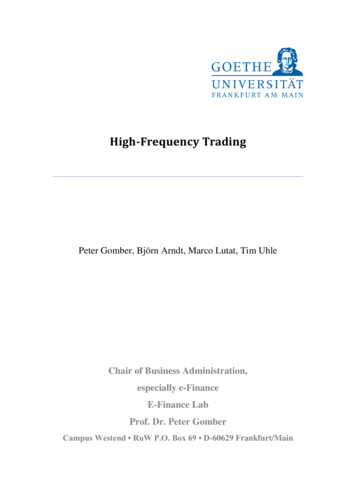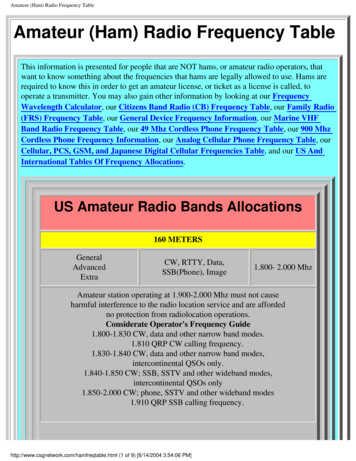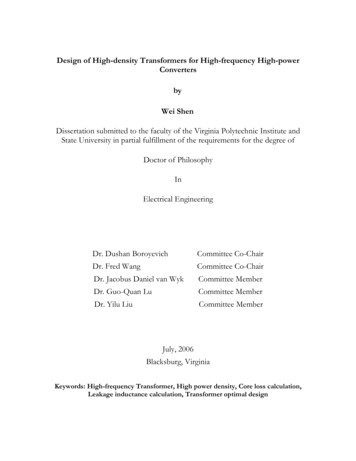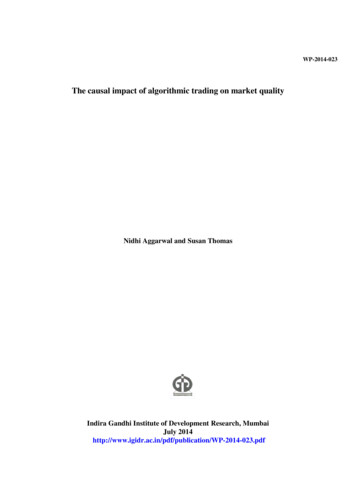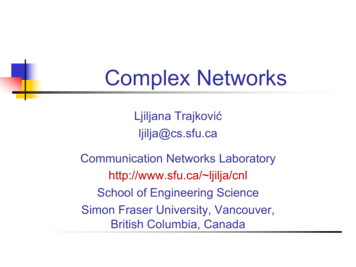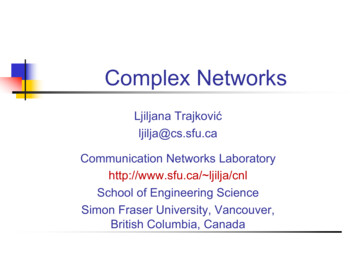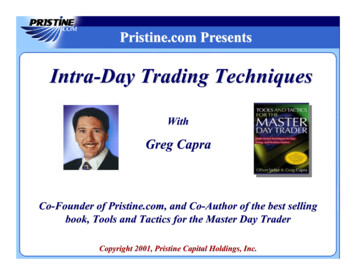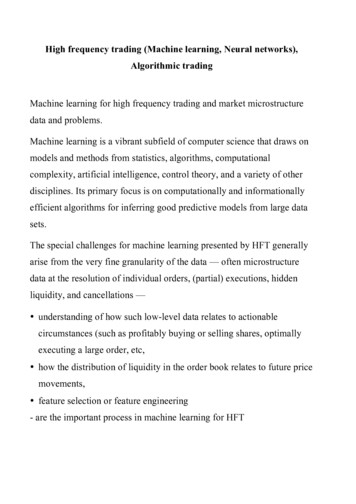
Transcription
High frequency trading (Machine learning, Neural networks),Algorithmic tradingMachine learning for high frequency trading and market microstructuredata and problems.Machine learning is a vibrant subfield of computer science that draws onmodels and methods from statistics, algorithms, computationalcomplexity, artificial intelligence, control theory, and a variety of otherdisciplines. Its primary focus is on computationally and informationallyefficient algorithms for inferring good predictive models from large datasets.The special challenges for machine learning presented by HFT generallyarise from the very fine granularity of the data — often microstructuredata at the resolution of individual orders, (partial) executions, hiddenliquidity, and cancellations — understanding of how such low-level data relates to actionablecircumstances (such as profitably buying or selling shares, optimallyexecuting a large order, etc, how the distribution of liquidity in the order book relates to future pricemovements, feature selection or feature engineering- are the important process in machine learning for HFT
High Frequency Data for Machine LearningHigh frequency trading - holding periods, order types (e.g. passive versusaggressive), and strategies (momentum or reversion, directional orliquidity provision, etc.).Data driving HFT activity tends to be the most granular available.Typically microstructure data - every order placed, every execution, andevery cancellation, and reconstruction (at least for equities) of the fulllimit order book.A single day’s worth of microstructure data on a highly liquid stock ismeasured in gigabytes. Storing this data historically for any meaningfulperiod and number of names requires both compression and significantdisk usage; processing this data efficiently generally requires streamingthrough the data by only uncompressing small amounts at a time.What systematic signal or information is contained in microstructuredata? - What “features” or variables can we extract from this extremelygranular, lower-level data.
Limit Order Trading and Market SimulationLimit order markets: By this we mean that buyers and sellers specifynot only their desired volumes, but their desired prices as well. A limitorder to buy (respectively, sell) V shares at price p may partially orcompletely execute at prices at or below p (at or above p).For example, suppose that NVIDIA Corp. (NVDA) is currently trading atroughly 27.22 a share (see Figure 1, which shows an actual snapshot ofan NVDA order book), but we are only willing to buy 1000 shares at 27.13 a share or lower. We can choose to submit a limit order with thisspecification, and our order will be placed in the buy order book, which isordered by price, with the highest price at the top (this price is referred toas the bid; the lowest sell price is called the ask). In the exampleprovided, our order would be placed immediately after the extant orderfor 109 shares at 27.13; though we offer the same price, this order hasarrived before ours. If an arriving limit order can be immediatelyexecuted with orders on the opposing book, the executions occur. Forexample, a limit order to buy 2500 shares at 27.27will cause executionwith the limit sell orders for 713 shares at 27.22, and the 1000-share and640-share sell orders at 27.27, for a total of 2353 shares executed. Theremaining (unexecuted) 147 shares of the arriving buy order will becomethe new bid at 27.27. It is important to note that the prices of executionsare the prices specified in the limit orders already in the books, not theprices of the incoming order that is immediately executed. Thus wereceive successively worse prices as we consume orders deeper in theopposing book.
Performance and policies found by RL vary with stock properties such asliquidity, volume traded, and volatilitySubmit and leave (S&L) policiesState-based strategies – strategies that can examine salient features of thecurrent order books and our own activity – in order to decide what to donext.Variables: elapsed time t, remaining inventory i, which represent howmuch time of the horizon H has passed and how many shares we haveleft to execute in the target volume V. Different resolutions of accuracywill be investigated for these variables, which we refer to as privatevariables, since they are essentially only known and of primary concernto our execution strategy. More precisely, we pick I and T, which are the
resolutions (maximum values) of the private variables i and t,respectively. I represents the number of inventory units our policy candistinguish between – if V 10,000 shares, and I 4, our remaininginventory is represented in rounded units of V/I 2,500 shares each.Similarly, we divide the time horizon H into T distinct points at whichthe policy is allowed to observe the state and take an action; for H 2 minand T 4 we can submit a revised limit order every 30 seconds, and thetime remaining variable t can assume values from 0 (start of the episode)down to 4 (last decision point of the episode).Additional state variables: market variables, a state has the formxm t, i, o1, , oR , where the oj are market variables.Action space: simple limit order price at which to reposition all of ourremaining inventory, for the problem of selling V shares, action acorresponds to placing a limit order for all of our unexecuted shares atprice ask - a. Thus we are effectively withdrawing any previousoutstanding limit order we may have (which is indeed supported by theactual exchanges), and replacing with a new limit order. Thus a may bepositive or negative, with a 0 corresponding to coming in at the currentask, positive a corresponding to "crossing the spread" towards the buyers,and negative a corresponding to placing our order in the sell book.Rewards: An action from a given state may produce immediate rewards,which are essentially the proceeds (cash inflows or outflows, dependingon whether we are selling or buying) from any (partial) execution of thelimit order placed. Furthermore, since we view the execution of all V
shares as mandatory, any inventory remaining at the end of time Hisimmediately executed at market prices --- that is, we eat into theopposing book to execute, no matter how poor the prices, since we haverun out of time and have no choice.Measure the execution prices achieved by a policy relative to the midspread price (ask bid)/2 at the start of the episode in question. Thus, weare effectively comparing performance to the idealized policy which canexecute all V of its shares immediately at the mid-spread, and thus areassuming infinite liquidity at that point.Trading cost of a policy: the underperformance compared to themidspread baseline.We assume that commissions and exchange fees are negligible.
Predicting Price Movement from Order Book StateLearn models that themselves profitably decide when to trade and how totrade: The development of features that permit the reliable prediction ofdirectional price movements from certain states. By “reliable” we donot mean high accuracy, but just enough that our profitable tradesoutweigh our unprofitable ones. The development of learning algorithms for execution that capture thispredictability or alpha at sufficiently low trading costs.First find profitable predictive signals: Bid-Ask Spread: Price: A feature measuring the recent directional movement ofexecuted prices. Smart Price: A variation on mid-price where the average of the bid andask prices is weighted according to their inverse volume. Trade Sign: A feature measuring whether buyers or sellers crossed thespread more frequently in recent executions. Bid-Ask Volume Imbalance: Signed Transaction Volume:Features above were normalized. In order to obtain a finite state space,features were discretized into bins in multiples of standard deviationunits.
Learning algorithm: buying 1 share at the bid-ask midpoint and holdingthe position for t seconds, at which point we sell the position, again at themidpoint; and the opposite action, where we sell at the midpoint and buyt seconds later. In the first set of experiments we describe, we considereda short period of t 10 seconds.The methodology can now be summarized as follows:For each of 19 names, order book reconstruction on historical data wasperformed.At each trading opportunity, the current state (the value of the sixmicrostructure features described above) was computed, and the profit orloss of both actions (buy then sell, sell then buy) is tabulated via orderbook simulation to compute the midpoint movement.Learning was performed for each name using all of 2008 as the trainingdata. For each state 𝑥 in the state space, the cumulative payoff for bothactions across all visits to 𝑥 in the training period was computed.Learning then resulted in a policy π mapping states to action, where 𝜋(𝑥)is defined to be whichever action yielded the greatest training setprofitability in state 𝑥.Testing of the learned policy for each each name was performed usingall 2009 data. For each test set visit to state 𝑥, we take the action 𝜋(𝑥)prescribed by the learned policy, and compute the overall 2009profitability of this policy.
FIGURE 4: Correlations between feature values and learned policies. Foreach of the six features and 19 policies, we project the policy onto justthe single feature compute the correlation between the feature value andaction learned ( 1 for buying, -1 for selling). Features indices are in theorder Bid-Ask Spread, Price, Smart Price, Trade Sign, Bid-Ask VolumeImbalance, Signed Transaction Volume.
FIGURE 5: Comparison of test set profitability across 19 names forlearning with all six features (red bars, identical in each subplot) versuslearning with only a single feature (blue bars).
Optimal strategy found: momentum behaviour for time periods of milliseconds to seconds, reversion strategies for dozens of seconds to several minutesAspects that one must consider when applying machine learning to highfrequency data: the nature of the underlying price formation process, andthe role and limitations of the learning algorithm itself.
Empirical Limitations on High Frequency Trading ProfitabilityEmpirical study estimating the maximum possible profitability of themost aggressive such practices: trading strategy exclusively employingmarket orders and relatively short holding periods.The overarching fear is that quantitative trading groups, armed withadvanced networking and computing technology and expertise, are insome way victimizing retail traders and other less sophisticated parties.The HFT debate often conflates distinct phenomena, confusing, forinstance, dark pools and flash trading, which are essentially new marketmechanisms, with HFT itself, which is a type of trading behaviourapplicable to both existing and emerging exchanges. The core concernregarding HFT, however, is relatively straightforward: that the ability toelectronically execute trades on extraordinarily short time scales,combined with the quantitative modelling of massive stores of historicaldata, permits a variety of practices unavailable to most parties. A broadexample would be the discovery of very short-term informationaladvantages (for instance, by detecting large, slow trades in the market)and profiting from them by trading rapidly and aggressively.We demonstrate an upper bound of 21 billion for the entire universe ofU.S. equities in 2008 at the longest holding periods, down to 21 millionor less for the shortest holding periods (see discussion of holding periodsbelow). Furthermore, we believe these numbers to be vast overestimatesof the profits that could actually be achieved in the real world. Thesefigures should be contrasted with the approximately 50 trillion annual
trading volume in the same markets. We believe our findings are ofinterest in their own right as well as potentially relevant to the ongoingdebate over HFT.Tension between two basic quantities: the horizon or holding period, asmeasured by the length of time for which a (long or short) position in astock is held; and the costs of trading, as measured by (at least) the bidask spread that must be crossed by market orders.We compute the profit or loss of the HF trader in hindsight, and reachempirical overestimates of profitability.Data: A small set of the most liquid (and therefore most profitable) stockson NASDAQ, and then use a slightly less detailed data set and regressionmethods to scale up our estimates to a much larger universe of all USstocks, and across all exchanges.Related literature: Aldridge examines foreign exchange trading.Chaboud et al. study foreign exchange markets: HFT does not cause anincrease in volatility. Hendershott et al. analyze trading of US equities,and find that HFT improves liquidity. The same authors examine Germanmarkets.
Constraints on HFT: aggressive order placement and short holdingperiods. We propose that aggressive orders are the greatest cause for anyconcerns about the negative impacts on trading counterparties; passiveorder placement can only improve the market both in prices and volumes.If one of the advantages of (and concerns over) HFT is the ability to veryrapidly take and liquidate positions to profit from short-terminformational advantages, aggressive order placement is necessary.For these reasons we shall restrict our attention to aggressive orderplacement.We shall consider holding periods as short as 10 milliseconds and as longas 10 seconds.Two different sources of raw trading data: order book data and Trade andQuote, or TAQ, data on a much larger set of stocks and exchanges.In this framework, we simulate the profitability of the following OT,whose only parameter is the holding period h: At each time t, the OT may either buy or sell v shares, for every integerv 0. The purchase or sale of the v shares occurs at market prices; thusaccording to the standard U.S. equities limit order mechanism, the OTcrosses the spread and consumes the first v shares on the opposing orderbook, receiving possibly progressively worse prices for successiveshares.
If at time t the OT bought/sold v shares, at time t h it must liquidatethis position and sell/buy the shares back, again by crossing the spreadand paying market prices on the opposing book. (We later discuss theeffects of allowing a variable holding period.) At each time t, the OT makes only that trade (buying or selling, and thechoice of v) that optimizes profitability. Obviously it is this aspect of theOT that requires knowledge of the future. Note that if no trade at t haspositive profitability, the OT does nothing.Details:1. If ℎ 0 then v 0 for most of t. This design for the OT accuratelycaptures the fundamental tension of (aggressive) HFT. If we denote thebid-ask spread at time t by st, it is clear that the purchase or sale of even asingle share by the OT will incur transaction costs on the order of at least½ (st st h) — the mean of the spreads at the onset and liquidation of theposition. Larger values for v will increase these costs, since eating furtherinto the opposing books effectively widens the spreads. Thus, in order fora trade of v shares to be profitable, the share price must have time tochange enough to cover the spread-based transaction costs. (Since weomnisciently optimize between buying and selling, as well as the trade
volume, sufficient movement either up or down will result in someprofitable trade.) Of course, the smaller the holding period h, the lessfrequently such fluctuations will occur — indeed, we find that forsufficiently small h, the vast majority of the time the optimal choice is v 0 — that is, no trade is made by the OT.2. Large data high computation time.3. We assume the trades of the OT have no impact on the market.4. We assume no trading fees or commissions are paid by the HFT.5. We assume that offers taken by the trader remain on the books,allowing the trader to repeatedly profit from a single opportunity as oftenas 100 times per second.6. No mixing: We do not allow the OT to enter a postion with a marketorder but exit with a limit order (or vice versa).7. No forward looking strategy8. We allow trading every 10 milliseconds conditioned on there being anychange.9. This also replicates the actual HFT during this period.
Omniscient Order Book Trading: Even at the longest holding period of10 seconds the total 2008 OT profits are only 3.4 billion, down to just 62,000 for the shortest (10ms) holding period.
Market-Wide ExtrapolationExtrapolate our results to all stocks and all exchanges by utilizing thebroader but somewhat less detailed Trade and Quote (TAQ). We estimatea primary-to-composite conversion ratio (in a given name, around 50% ofprofits come from the primary exchange.The earlier target 19 stocks traded primarily on NASDAQ, are also tradedon a variety of alternative exchanges that in some instances may offerbetter pricing. TAQ data are limited in do not record liquidity offeredbeyond the current bid and ask prices.
At each time t, the OT can buy or sell v shares, where v 0 is an integerbounded by the number of shares available to buy (sell) at the ask (bid) attime t as well as the number of shares available to sell (buy) at the bid(ask) at time t h. For example, if 100 shares are offered at the ask priceat time t and 50 shares are offered at the bid price at time t h, then theOT can only consider buying up to 50 shares at time t. (Since the trader isomniscient, it can compute these limits even though they depend onfuture information.) As before, any position taken at time t must beliquidated at time t h.The modified OT (simulated on TAQ data) occasionally achieves higherprofits than the original OT. Correlation is 0.969. We assume that theoriginal OT’s profits are closely estimated as a multiple of the modifiedOT’s profits. So we directly apply extrapolation ratios.
Extrapolation scheme:Other exchanges TAQ modified OT (1)NASDAQOrder book OT(2)Profit vs. Quoteregression19 stocksAll of ΩStep (1): On average, profits increase by a factor of 2.1. Finally, weestimated composite profits of the original OT by multiplying the profitsreported in Section 6 by the corresponding ratios depicted in Figure 6.Step (2) Regression: Figure 7 shows the fit between profits and thenumber of TAQ quotes achieved by a simple two-parameter power lawmodel for the same 19 stocks. The R2 value is 0.968. Using thisregression, we can quickly estimate potential profits for a full universe of6,279 US stocks, yielding a bound on the total HFT profits available inall of 2008 at 10 second holding: 21.3 billion.
Machine learning approach offers no easy paths to profitability: Evenif all the features we enumerate here are true predictors of future returns,and even if all of them line up just right for maximum profit margins, onestill cannot justify trading aggressively and paying the bid-ask spread,since the magnitude of predictability is not sufficient to cover transactioncosts.
References:[1] Michael Kearns and Yuriy Nevmyvaka, Machine Learning for MarketMicrostructure and High Frequency Trading, in High Frequency Trading- New Realities for Traders, Markets and Regulators, David Easley,Marcos Lopez de Prado and Maureen O’Hara editors, Risk Books, ing[2] Yuriy Nevmyvaka, Yi Feng, and Michael Kearns. ReinforcementLearning for Optimized Trade Execution. In Proceedings of the 23rdinternational conference on Machine learning, pages 673–680. ACM,2006.[3] A. Kulesza, M. Kearns, and Y. Nevmyvaka. Empirical Limitations onHigh Frequency Trading Profitability. Journal of Trading, 5(4):50–62,2010.[4] K. Ganchev, M. Kearns, Y. Nevmyvaka, and J. Wortman. CensoredExploration and the Dark Pool Problem. Communications of the ACM,53(5):99–107, 2010.[5] R. Cont and A. Kukanov. Optimal Order Placement in Limit OrderMarkets. Technical Report, arXiv.org, 2013.
High frequency trading (Machine learning, Neural networks), Algorithmic trading Machine learning for high frequency trading and market microstructure data and problems. Machine learning is a vibrant subfield of computer science that draws on mode
